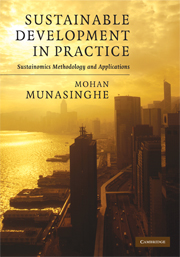Book contents
- Frontmatter
- Contents
- Foreword by James Gustave Speth
- Preface
- Part I Framework and fundamentals
- Part II Global and transnational applications
- Part III National and macroeconomic applications
- Part IV Sub-national sectoral and system applications
- Part V Project and local applications
- 15 Project applications
- 16 Local applications – hazards, disasters and urban growth
- References
- Index
15 - Project applications
Published online by Cambridge University Press: 05 August 2012
- Frontmatter
- Contents
- Foreword by James Gustave Speth
- Preface
- Part I Framework and fundamentals
- Part II Global and transnational applications
- Part III National and macroeconomic applications
- Part IV Sub-national sectoral and system applications
- Part V Project and local applications
- 15 Project applications
- 16 Local applications – hazards, disasters and urban growth
- References
- Index
Summary
Applications of the sustainomics approach at the project level are illustrated in this chapter. In Sections 15.1 and 15.2, the sustainable energy development framework applied at the sector level (Chapter 10) is extended and used to evaluate small hydroelectric power projects in Sri Lanka. Multicriteria analysis is used to assess social, economic and environmental indicators. Section 15.3 highlights the use of different policy tools (including the interplay of shadow and market prices) – to influence human behaviour relating to new and renewable energy use in a typical developing country. Practical investment and pricing policies are formulated to make energy development decisions more sustainable, in the case of solar photovoltaic energy projects for agricultural pumping. In Section 15.4, rural electrification projects in Sri Lanka are analysed, focusing on new and renewable energy technologies. Rural energy priorities (solar homes and village hydro) in Sri Lanka are compared with renewable energy projects in the Philippines and Vietnam. Section 15.5 presents a case study involving the analysis of a project that supplies water to a poor African village, by drilling wells and boreholes. The focus is on quantitative economic cost–benefit analysis, using both border and domestic shadow prices to determine water-investment decisions and pricing policy.
Small hydro-projects and sustainable energy development in Sri Lanka
Energy is a key resource which affects the economic, environmental and social dimensions of sustainable development (see Chapter 10). Further, hydroelectricity is a key renewable source of energy that contributes toward sustainable energy development (UNEP, 2000).
- Type
- Chapter
- Information
- Sustainable Development in PracticeSustainomics Methodology and Applications, pp. 503 - 543Publisher: Cambridge University PressPrint publication year: 2009



